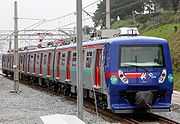Salvador Metro
| Salvador Metro | |
|---|---|
 | |
| Background | |
| Locale | Salvador, Bahia |
| Transit type | Rapid transit |
| Number of lines | 2 |
| Number of stations | 19 |
| Operation | |
| Began operation | Line 1 unpredicted, and Line 2 in 2014 |
| Operator(s) | Companhia de Transportes de Salvador |
| Technical | |
| System length | 30km |
The Salvador Metro (Portuguese: Metrô de Salvador, commonly called Metrô) is a currently under-construction metro project for the city of Salvador, Brazil. The system includes Line 1 (Lapa-Acesso Norte), Line 2 (Rótula do Abacaxi-Aeroporto-Lauro de Freitas) and the first railway line in the city known as the Suburban Line (Calçada-Paripe).
The project is a Build, Operate, and Transfer (BOT) scheme for the operation of the urban rapid rail transportation system in the municipality of Salvador da Bahia, and includes the supply and installation of rolling stock and signaling equipment, and commercial operation of the system for the 25-year concession. Each train, consisting of four cars, has the capacity to carry 1,250 passengers.[1]
Currently, the urban transportation system in Salvador is underdeveloped and largely road-based, causing significant congestion and delays. This level of road-based transport has significant impacts on the local economy and environment. For this reason the municipality and the state, together with the World Bank, have been involved since 1992 in the design and implementation of a transportation strategy. The international standard gauge is 3kV overhead power supply. And Built by a consortium of Siemens and Camargo Corrêa and Andrade Gutierrez of Brazil.[2]
This project is an integral part of the strategy. The project aims to improve the quality of public urban transportation in the area by connecting currently-excluded low-income neighborhoods, and by furthering the development of a fully integrated urban transportation system.[3]
Salvador Metro system is one of the actions of urban mobility that will be deployed until the 2014 FIFA World Cup. The connection of Line 2 with Line 1 of Salvador Metro contributes to connect the International Airport to Downtown Salvador and the Fonte Nova Stadium. The new Line 2 of Salvador Metro integrates the metro stations of the Rótula do Abacaxi and the beach city of Lauro de Freitas in the metropolitan area, passing through the Salvador International Airport, with the Airport metro station.[4]
The Line 1 connects to the Transfer of Lapa, the largest of Salvador, to Rótula do Abacaxi, passing by Fonte Nova Stadium, the official stadium of FIFA World Cup, the stadium has a metro station of Line 1. Also in this Line of the Metro exist the junction between the main avenues of Salvador with the busiest highway in the State of Bahia, BR-324, in the area of Rótula do Abacaxi, which connects the city to Feira de Santana. Also located on the local, the Bus station of Salvador, the largest of Bahia, which is located across from the Iguatemi Mall, and the most important Central Business District of Salvador, in the area of Iguatemi.[5]
See also
- List of rapid transit systems
References
- ↑ Trains of Salvador Metro
- ↑ Urbanrail - Salvador Metro
- ↑ Salvador Metro - Project
- ↑ 2014 FIFA World Cup
- ↑ Line 1 - Salvador Metro
| |||||||||||||||||||||||
